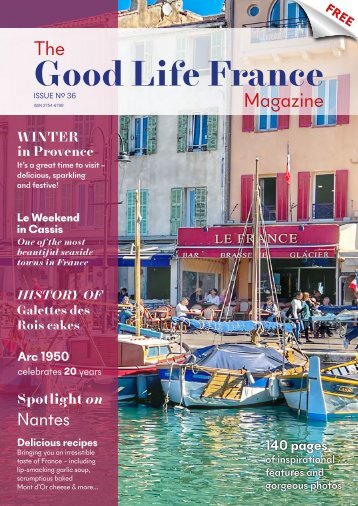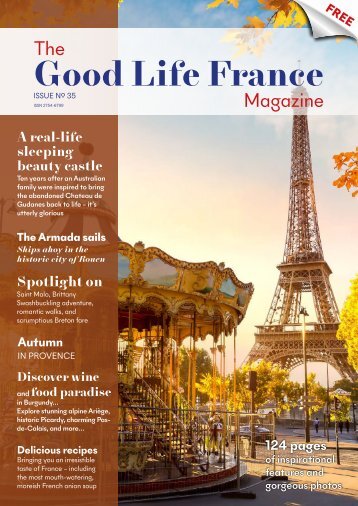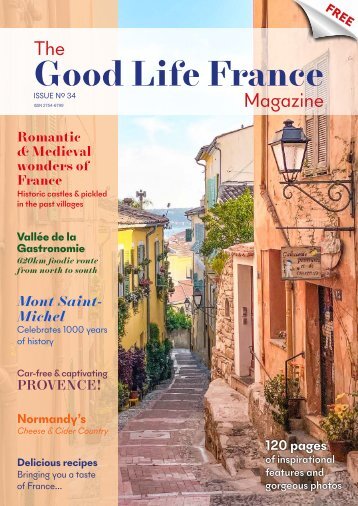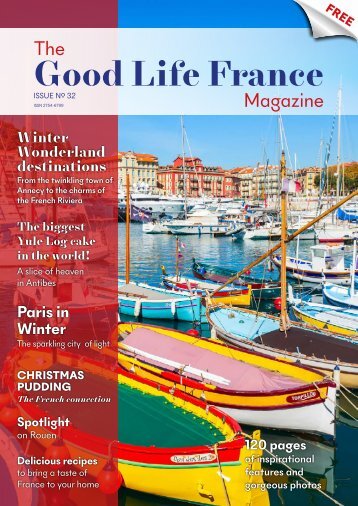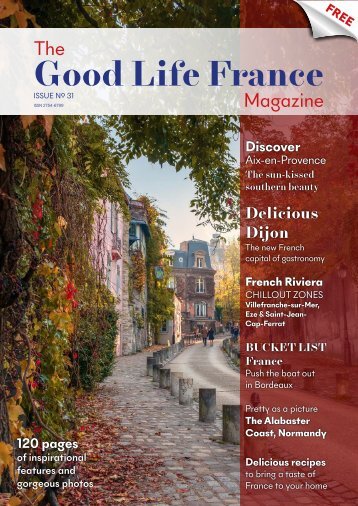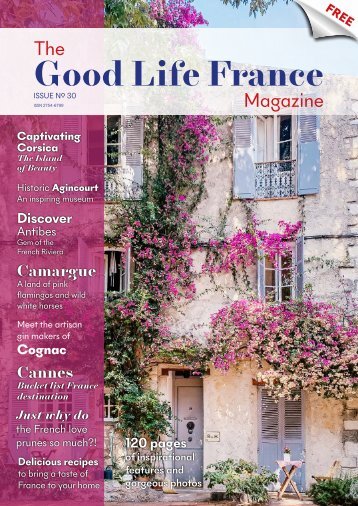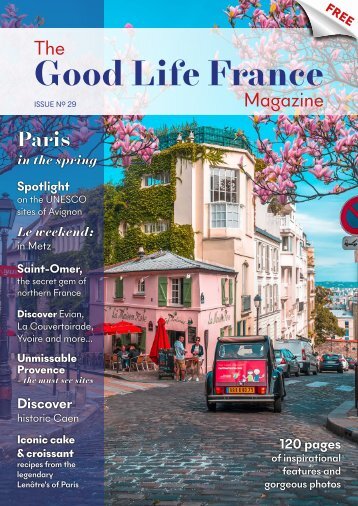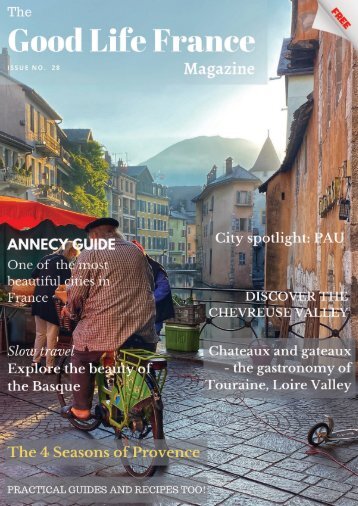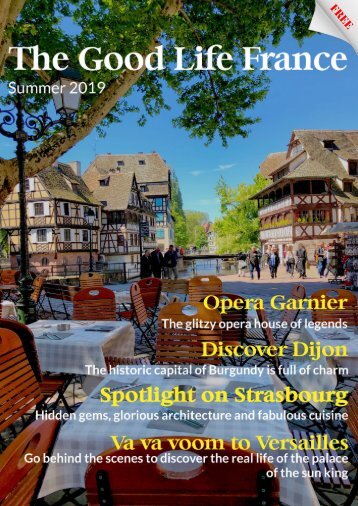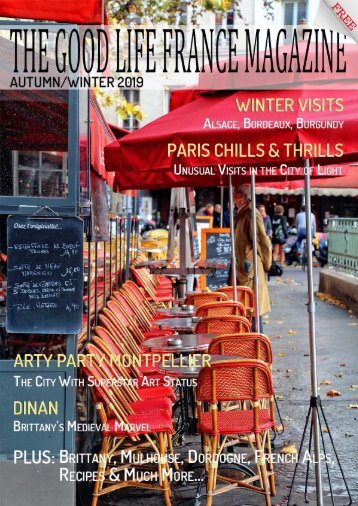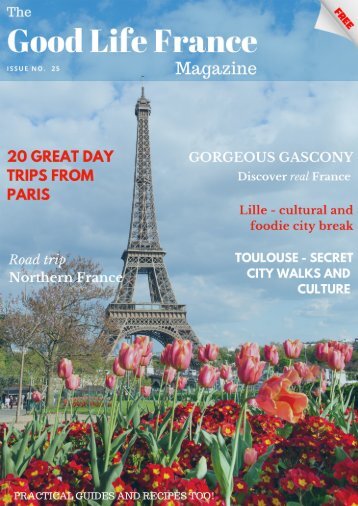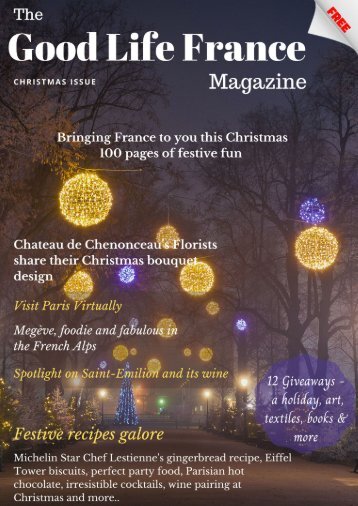
The Good Life France Magazine
The Good Life France Magazine brings you the best of France - inspirational and exclusive features, fabulous photos, mouth-watering recipes, tips, guides, ideas and much more...
Published by the award winning team at The Good Life France
Issue No. 19
Visiting the 12th
Visiting the 12th century Abbaye Notre-Dame de Sénanque in May before its renowned lavender fields had burst into vibrant bloom, Martha McCormick discovered equal beauty in its austere Romanesque interior. Located near Gordes in Provence, the abbey is occupied by a community of Cistercian monks. The Roman Catholic Cistercian Order grew from a late 11th century reform movement started by monks who wished to return to the pure traditions of monastic life practiced in Saint Benedict’s time. Following the strictures of Cistercian design, the abbey lacks decorations such as frescoes, sculptures, or stained glass windows with Biblical illustrations. According to the early founders, these ornamentations were meant for lay people who had little access to the Bible. Decoration brought them closer to God. For the devout monks, however, such embellishment was unnecessary and would distract them from prayer. Thus, the decorative elements allowed are those of the architecture itself: vaults, arches, stairways, transepts, capitals and columns. These were constructed using the finest methods because the Cistercian monks highly valued craftsmanship. Stonecutters were particularly prized, and each initialed the stones they cut as a matter of pride. One might think this austerity creates a rather drab place. But instead, the austere décor heightens the beauty of the pale gray stone and the purity of line. Added to this is the welcoming of light: la vrai Lumière—the true light—a symbol of God. According to an early founder, Saint Bernard: “…shadow and darkness shall disappear and the splendor of the true Light will invade the whole space…”
Far left: For the monks, the cloister is a symbol of “Paradise regained.” It stands at the heart of the monastery. Here monks find a natural spot for silent prayer and meditation. Above: The play of light and the simplicity of architectural structure create serene beauty. The Abbey of Senanque today At its peak in the 13th and 14th centuries, Sénanque abbey owned extensive properties all over Provence, including four water mills, seven granges, and four or five hospices, in addition to fields, forests and pastures. Troubled times followed when the abbey was partly destroyed during the War of Religions in the 16th century, and later was sold off as state property after the Revolution. In 1854, it was purchased and restored by a community of monks, who were later expelled. The current community dates back to 1988. Today, the monks still follow the precepts of Cistercian monastic life: liturgical prayer sung in church; silent reading, meditation and prayer; and manual and intellectual work. The brothers work in agriculture (lavender, honey, and forestry) and tourism (guided tours, bookshop, and building restoration.) The shop is very much worth a visit, offering the monks’ honey and lavender products, a wide selection of religious and historical books, and many other gifts.
- Page 3 and 4: Bonjour! Summer is served in this i
- Page 5 and 6: contents P. 8 p. 25 P. 30 p 26 Feat
- Page 7: p. 62 p. 102 p. 54 p. 68 p. 78 Expe
- Page 10 and 11: The Secret World of Castles… Not
- Page 12 and 13: Chateau de Sully, Saone-et-Loire Ma
- Page 14 and 15: Château de Couches, Saône-et-Loir
- Page 17 and 18: Château d’Arlay, Jura, Franche-C
- Page 19: Citadel of Besanson, Jura The immen
- Page 22 and 23: The Calvados Experience You can fin
- Page 24 and 25: Chicken with Calvados Ingredients f
- Page 27 and 28: What's new for France in Summer 201
- Page 29 and 30: Lake Annecy to host Europe’s bigg
- Page 31 and 32: La Boumette, Paris From 22 June to
- Page 33 and 34: The best place to start exploring i
- Page 35 and 36: Photo: Diane Francis Cook Follow th
- Page 37: Throughout the year the city is als
- Page 43: Tours of the abbey are offered year
- Page 46 and 47: 1 Place du Capitole The Place du Ca
- Page 48 and 49: 6 See the sites Photo © Toulouse T
- Page 50 and 51: 12 Gourmet city 13 Bake my day With
- Page 52 and 53: 1- Festivals There are more than 10
- Page 55 and 56: The best markets in France - its of
- Page 57 and 58: Colmar Market Colmar, Alsace The ma
- Page 59 and 60: Royan Market Poitou-Charentes Held
- Page 62 and 63: Photo © P Vincent ND Lourdes
- Page 64 and 65: Photo © Studio GP Photos The giant
- Page 66 and 67: Photo © Santuaries ND Lourdes P Vi
- Page 69 and 70: Understated Luxury: The Coco Chanel
- Page 71 and 72: While the designs are vintage, they
- Page 73 and 74: Culture Vulture The Royal Basilica
- Page 75 and 76: Locals love: The Abbesses district
- Page 77 and 78: Lavender in Provence by Kim Rusche
- Page 79: w a y s - WIN Click on the pic to e
- Page 82 and 83: Mike created an enclosure for the s
- Page 84 and 85: Mike is a walking encyclopaedia of
- Page 86 and 87: Meet the Brits who run the best Lux
- Page 88 and 89: When it was time to head home to th
- Page 90 and 91:
Never mind a pretty house, with spe
- Page 92 and 93:
Farms With land prices currently ve
- Page 95:
Do you have to be wealthy to benefi
- Page 98 and 99:
The Basics of Banking in France The
- Page 100 and 101:
Pre order M book at: Eat In the Fre
- Page 102 and 103:
Serves 6 Prep time: 20 minutes Bake
- Page 105 and 106:
Scrumptious Chestnut and Chocolate
- Page 108:
www.ofx.com
Inappropriate
Loading...
Mail this publication
Loading...
Embed
Loading...



